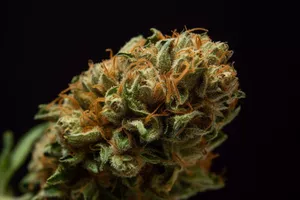
White Widow Cannabis Strain
Your Cannabis AI assistant
*By signing up, you agree to the Terms and Conditions and Privacy Policy. California residents, see our CA Privacy Notice.
Unlock the full potential of White Widow Cannabis Strain
White Widow, a renowned hybrid strain, has captivated cannabis enthusiasts worldwide since its emergence in the early 1990s. With its global popularity and frequent appearance on Amsterdam coffee shop menus, this strain has become a staple in the cannabis community. The influence of popular culture, including television shows like Weeds and references in the rap industry, has further propelled White Widow into the limelight.
Boasting a well-balanced 60:40 sativa-to-indica ratio (a cross between Brazil Sativa and South Indian Indica), White Widow offers a cognitive-driven high accompanied by a soothing undertone. It is the go-to strain for individuals seeking relaxation while maintaining mental awareness. Notably, it is highly regarded for its potential therapeutic benefits, particularly in managing depression, stress, pain, and PTSD. In this article, we will delve deeper into the captivating characteristics of the White Widow, exploring its effects, aroma, taste, and outdoor-friendly nature.
Effects and Therapeutic Benefits:
Users can expect a powerful and invigorating experience when indulging in White Widow. With its sativa dominance, this strain induces an energetic and uplifting high, perfect for those seeking a boost of vitality and creativity. Engaging in conversations and tapping into your artistic side becomes effortless, as White Widow stimulates social interaction and imaginative thinking. Its balanced effects make it ideal for individuals desiring relaxation while maintaining mental acuity.
Moreover, White Widow has garnered a reputation for its potential therapeutic benefits. Patients dealing with stress, anxiety, pain, and PTSD have found solace in this strain. The uplifting and mood-enhancing properties of White Widow can alleviate symptoms of depression and anxiety, providing a welcomed sense of relief. Furthermore, its analgesic properties make it a promising option for managing various forms of pain. White Widow may offer a respite from these burdens, whether it's physical discomfort or the emotional toll of traumatic experiences.
Aesthetic Appeal and Aroma:
One of the most striking features of White Widow is its appearance. The buds are blanketed in a glistening layer of white crystals, reminiscent of a snowy winter wonderland. These resinous trichomes are not merely visually captivating but also indicate the strain's potency. Prepare yourself for a potent and unforgettable experience when encountering White Widow.
In terms of aroma, White Widow offers a delightful sensory experience. As you inhale, you'll be greeted with a citrusy and peppery scent that instantly invigorates the senses. The fragrance is uplifting and tantalizing, setting the stage for the upcoming euphoric journey. Upon exhaling, a subtle lemony aftertaste lingers, leaving a refreshing and pleasant sensation.
White Widow's versatility extends beyond its effects and therapeutic potential. This strain is well-suited for recreational activities, particularly those enjoyed in the great outdoors. Whether you're planning a day at the beach or a leisurely walk through nature, White Widow can enhance your experience. The energizing and invigorating effects promote an active and engaged mindset, perfect for exploring and embracing the world's beauty.
Frequently Asked Questions (FAQs):
What is the genetic makeup of White Widow?
White Widow is a hybrid strain with a genetic composition of 60% sativa and 40% indica. It is a cross between a Brazilian sativa landrace and a resin-rich South Indian indica.
What are the THC and CBD levels in White Widow?
White Widow typically contains THC levels ranging from 18% to 25%. CBD levels are relatively low, measuring around 1%. Additionally, CBN levels are also around 1%.
What are the primary effects of White Widow?
White Widow induces an energetic and uplifting high, promoting conversation, creativity, and a sense of vitality. It provides a cognitive-driven experience while also allowing for relaxation and mental awareness.
Are there any potential negative side effects?
Some common negative side effects of White Widow include dry mouth, dry eyes, and in some cases, paranoia. It is advisable to stay hydrated and use eye drops to mitigate discomfort. Moderation and a comfortable environment can help minimize the likelihood of experiencing paranoia.
Which conditions does White Widow help with?
White Widow has shown promise in alleviating symptoms of stress, anxiety, pain, and PTSD. Its mood-enhancing and analgesic properties make it a potential option for individuals seeking relief from these conditions.
Can White Widow be enjoyed outdoors?
Absolutely! White Widow's energizing and invigorating effects make it an excellent companion for outdoor activities. Whether you're relaxing at the beach or taking a refreshing walk, White Widow can enhance your experience.
White Widow Grow Information
White Widow weed is relatively resistant to molds, pests, and colder climates, which is why it is the perfect strain for beginner growers.
White Widow was initially bred to be cultivated indoors, but those living in warm, sunny climates may successfully grow it outdoors.
Your White Widow plant will grow to about two feet tall indoors and even taller outside, flourishing in a hydroponics system or soil growth.
A typical indoor yield is about twenty to twenty-four ounces per square meter, and an outdoor-grown White Widow plant typically yields up to twenty-five ounces of flower per plant.
White Widow's flowering stage ends at around eight to ten weeks when grown indoors. Harvest time outdoors is late October for best results.
A Journey into the Diverse World of Strains
Types of Cannabis Strains:
Cannabis strains are generally classified into three main types, each with distinct characteristics and effects:
- Indica: Known for their relaxing and calming effects, Indica strains are often favored for evening use, stress relief, and relaxation. They are typically associated with a "body high" and may promote physical relaxation and sleep.
- Sativa: Sativa strains are known for their uplifting and energizing effects, making them popular for daytime activities, creative pursuits, and socializing. They tend to produce a more cerebral or "head high" and may stimulate creativity and focus.
- Hybrid: Hybrid strains are a combination of Indica and Sativa genetics and offer a balance of effects. They are available in various ratios (e.g., Indica-dominant, Sativa-dominant, or balanced) and may exhibit characteristics of both parent strains.
Cannabinoids and Terpenes:
Cannabis plants contain a variety of chemical compounds called cannabinoids and terpenes that contribute to the strain's effects, flavors, and aromas:
- Cannabinoids: The most well-known cannabinoids are THC (tetrahydrocannabinol) and CBD (cannabidiol). THC is responsible for the psychoactive effects of cannabis, while CBD is non-intoxicating and may have therapeutic properties. The ratio of THC to CBD in a strain can influence its overall effects.
- Terpenes: Terpenes are aromatic compounds found in cannabis and other plants. They give each strain its unique scent and flavor profile (e.g., citrusy, earthy, fruity) and may also influence the strain's effects.
Choosing the Right Strain:
Selecting the right cannabis strain depends on individual preferences and desired effects. Consider the following factors when choosing a strain:
- Desired Effects: Consider the type of experience you're seeking, whether it's relaxation, pain relief, creativity, or socializing.
- Tolerance: If you're new to cannabis or have a lower tolerance, consider strains with lower THC levels or strains with a balanced THC-to-CBD ratio.
- Medical Conditions: If you're using cannabis for medical purposes, specific strains may be more suitable for addressing particular symptoms or conditions.
Responsible Consumption:
Cannabis affects everyone differently, so it's important to consume responsibly and start with a low dose, gradually increasing as needed to find your ideal experience. Be mindful of the method of consumption (e.g., smoking, vaping, edibles) as it can impact the onset and duration of effects.
Legal Considerations:
Familiarize yourself with local cannabis laws and regulations regarding marijuana use, possession, and purchase. Laws vary by location, and it's important to ensure compliance.
Remember, the information provided in this section is intended to serve as a general guide. Consult with a cannabis healthcare professional for specific medical concerns, and always verify the legality of cannabis in your location.











